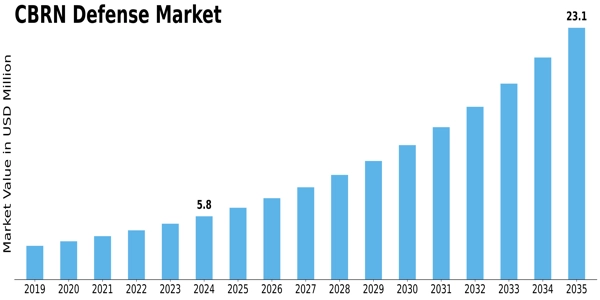Future of CBRN Defense: How AI and Advanced Sensors Are Transforming Threat Response

Examining the market size, share and growth forecast for the CBRN defence market reveals strategic opportunities for companies willing to innovate, partner and align with evolving defence/ homeland-security requirements. MRFR forecasts the market at USD 17,504.6 million by 2030, growing at a CAGR of 5.72%.
Strategic Opportunity A: Integration of services and hardware
Beyond pure equipment (protective suits, gas masks, detectors), there is growing opportunity in services — training, simulation, software/analytics, information-management systems. The segmentation indicates “simulators” and “information management software” as system types. Organisations that can bundle hardware + software + training are likely to capture higher share, differentiate themselves and build recurring revenue.
Strategic Opportunity B: Modular, mobile solutions for civil and law-enforcement markets
While the military remains the lead application, civil law enforcement and emergency response represent growing segments. MRFR identifies civil law enforcement as a distinct application segment. Mobile, modular CBRN defence solutions (vehicle-mounted systems, portable detectors, rapid-deployment decontamination) are well suited for civil markets and can help players expand beyond traditional defence customers.
Strategic Opportunity C: Growth in emerging regions with tailored offerings
Emerging markets in Asia-Pacific, the Middle East & Africa offer opportunity due to increasing defence budgets and first-responder preparedness. Although MRFR’s summary focuses more on North America and Europe, the segmentation by region implies emerging regional opportunity. Firms may focus on cost-effective solutions, local partnerships and regional supply chains in these markets.
Strategic Opportunity D: Focus on niche agent specialisations (bio/radiological)
As the threat landscape evolves, biological and radiological threats are gaining prominence. While chemical agents have traditionally dominated, market evolution gives room for entrants specialising in bio-threat detection, radiological monitoring or nuclear fallout response. MRFR’s type segmentation includes these categories.
Strategic Opportunity E: Cross-industry collaboration and dual-use technologies
CBRN defence intersects with public-health, disaster-response and critical-infrastructure protection sectors. This allows expansion of value-chain beyond traditional defence, into commercial, infrastructure and health-security segments. Organisations that adopt dual-use technologies (e.g., portable detectors, wearables, software) can tap broader markets beyond military procurement.
Actionable implications for managers
-
Develop integrated offerings combining hardware, software and services, rather than hardware alone.
-
Expand addressable market by targeting civil law enforcement, emergency response and critical-infrastructure segments, not just military.
-
Tailor product portfolios for emerging markets (focus on affordability, modularity, local support).
-
Invest in niche threat-areas (bio/radiological) and emerging technologies (analytics, connectivity, mobility).
-
Explore partnerships or alliances with public-health, infrastructure-protection or commercial-security firms to broaden reach.
In conclusion, while the market size and growth of the CBRN defence market industry are moderate, the strategic opportunities are significant — especially where companies innovate in offerings, expand addressable segments and engage emerging markets. Aligning business models to these opportunities offers a path to capture greater share and value in the evolving industry.
5 FAQs
-
What are strategic growth areas in the CBRN defence market?
Strategic growth areas include integrated hardware-software-services offerings, mobile/portable solutions for civil/emergency markets, emerging regional markets, niche-type segments (bio/radiological) and dual-use technologies. -
Why should companies target civil law-enforcement and emergency-response markets?
Because while military procurement remains strong, the civil sector is less saturated, offers new customers and addresses growing demand for first-responder equipment, infrastructure protection and public-safety readiness. -
How important is tailoring for emerging markets?
Very important. Emerging markets often require cost-effective, modular solutions, localised support and flexible business models. Entry into these markets can open new revenue streams beyond saturated developed markets. -
What kind of product mix is likely to win in the future?
A mix of detection, protection, decontamination, simulation/training and information-management offerings — bundled or interoperable — is likely to win, rather than standalone hardware alone. -
How should companies reposition to capture future opportunities?
They should invest in software/services, expand into civil and infrastructure segments, develop region-specific strategies, specialise in emerging threat-types (bio/radiological) and pursue partnerships to enhance ecosystem strength.
- Art
- Causes
- Crafts
- Dance
- Drinks
- Film
- Fitness
- Food
- Oyunlar
- Gardening
- Health
- Home
- Literature
- Music
- Networking
- Other
- Party
- Religion
- Shopping
- Sports
- Theater
- Wellness


